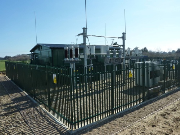 Storage of energy remains a difficult and expensive global challenge that struggles to compete with primary fuel storage.
Storage of energy remains a difficult and expensive global challenge that struggles to compete with primary fuel storage.
UK Power Networks is one company that is exploring new ways to store energy more efficiently and has been recognised by the Institution of Engineering and Technology (IET) for its most far reaching project to date.
The production of the dynamic electrical energy storage system (ESS) is the first example of an energy storage system of its kind in the UK and among the first in Western Europe to advance the integration of power generation from wind and solar power.
Recognised for its impact on social and economical conditions, the ESS project commissioned by UK Power Networks was shortlisted for the Energy category at the IET’s 2011 Innovation Awards. The initiative demonstrated that it could meet the pressures of an increasingly built-up environment as Britain’s demand for alternative sources of power continues to grow.
UK Power Networks is responsible for delivering safe, secure and sustainable power supply to eight million homes and businesses across the country. As the electricity supply industry is faced with growing pressures, UK Power Networks continues to explore the ways that energy could be stored to overcome the challenge of intermittent power production through renewable sources.
UK Power Networks commissioned a pilot project to take place in a small substation off a coastal village in Norfolk, which culminated in a new kind of technology that could harness power from local wind turbines and store it, to be used in the electricity distribution network when it was needed.
The pilot project in collaboration with ABB, Scottish Power Energy Networks and six universities, was carried out in a substation site in Hemsby, near Great Yarmouth. Battery technology was tested to see how much energy could be stored by the locally sited wind turbines, as the power generation exceeded the demand on the distribution network.
Peter Lang, from UK Power Networks’ Future Networks team, said, “One objective of the original pilot installation was to regulate the variable nature of the energy generated by the wind turbines. The storage device can provide more than this single service, with a range of voltage control and power flow management capabilities ready for implementation, to benefit the operator and users of the network.”
Using battery technology developed by ABB, UK Power Networks used the trials to design the energy storage system (ESS), which could be continually charged and discharged, and store electrical energy for later use. Relatively small in scale, the trials consisted of eight stacks of 13 lithium-ion battery modules which were continually charged and discharged storing up 200kWh of electrical energy – enough energy to power up to 200 houses for at least an hour.
By enabling dynamic control of power in the distribution network, the ESS demonstrated an improvement in grid voltage and stability, levelling out power fluctuations where energy was generated from renewable resources. The rated power and storage capacity is typically about 200kW for approximately one hour, but the technology has the potential to be scaled up to 50MW and for longer durations.
However, the first deployment of an ESS on a UK electricity distribution network did bring with it considerable challenges in the approval of this new technology.
 “The trial marked the first time an electrical energy storage system using Lithium-ion batteries had been installed on an 11kV distribution network in the UK and as the electricity network operator, UK Power Networks needed to ensure that this new technology did not have a detrimental impact on the security of supply of existing customers,” commented Lang.
“The trial marked the first time an electrical energy storage system using Lithium-ion batteries had been installed on an 11kV distribution network in the UK and as the electricity network operator, UK Power Networks needed to ensure that this new technology did not have a detrimental impact on the security of supply of existing customers,” commented Lang.
“Several staff involved in the project are members and fellows of the IET and so we have been able to make use of the institution’s extensive network of knowledge and hub of services to generate interest around the project. This was the first use of Lithium ion battery storage installed in the UK so we wanted to share our work with the industry and the IET gave us another opportunity to do that. Becoming shortlisted for the 2011 IET Innovation Awards allowed the company to raise the company’s profile for its research, development and demonstration activities,” said Lang.
The status of this current project is now at a monitoring stage, which is being conducted by Durham University. The project will undertake a series of ongoing modelling and simulation studies to evaluate the most effective way to operate the ESS on a distribution network. These simulations have been designed to improve multiple concurrent network performance metrics while ensuring no negative impacts are experienced in comparison to normal operation of the network. If it proves successful, the design could be replicated and scaled up for future applications throughout the UK.
UK Power Networks has since continued to work with the IET to use its knowledge network to gain a better understanding for future developments. By keeping in regular contact with both the Energy sector as a trusted source of essential engineering intelligence, UK Power Networks has looked to the IET as a project partner in its Low Carbon Networks Fund project – Flexible Plug and Play – to improve the network access for onshore wind generation.
Lang concluded, “Through working with the IET, UK Power Networks has been able to gain an understanding of the challenges to enable us to prepare with confidence, a Low Carbon Networks Fund bid for a larger installation. The ESS trial has helped us to understand the wider system benefits of electrical energy storage and regulatory frameworks that might need to change to allow storage to play its full role in helping deliver the government’s Carbon Plan by 2020, and the IET has helped facilitate this process.”




